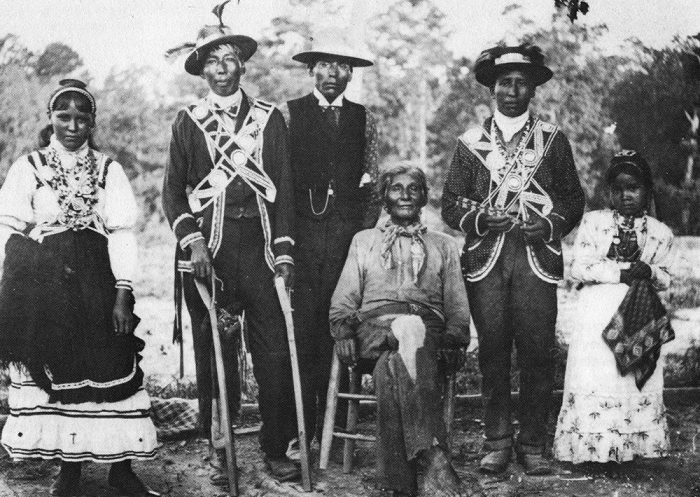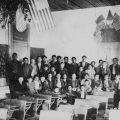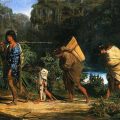The Choctaw, at the time of European contact, were a loosely organized confederacy composed of three distinctly different divisions: Okla Falaya (Long People), Okla Tannap (People of the Opposite Side), and Okla Hannalia (Sixtown People). The people were living in more than 100 autonomous villages. While there is a stereotype that portrays Indians as “living by the hunt,” the Choctaw, like the other Indian nations in the Southeast, were farmers who had been cultivating corn for about 3,000 years. In addition to corn, they also raised beans, squash, sunflowers, and melons.
Choctaw agriculture was supplemented with some hunting and gathering of wild plants for food and fiber. While men generally hunted and women generally worked in the fields, this was not a rigid division of labor. There were times when the men helped with both the farming and the gathering of wild plants. It was not uncommon for girls to go with the men and boys on hunting expeditions. Older women usually stayed at home to tend the fields.

Migrations:
Choctaw oral tradition speaks of a time when they had lived to the northwest. However, their population increased and the game grew scarce which forced them to seek a new home. Their migration was led by Chahta (also spelled Chah-tah) who carried a magical staff. Each night when they camped, he would place the staff upright into the ground. In the morning, he would inspect it and then he would lead the people in the direction in which the staff leaned. At the ancient mound of Ninih Waiya (“Leaning Mountain”) near present-day Philadelphia, Mississippi, the staff remained upright in the morning. Thus it was here that the Choctaw settled. It was in this country that the Choctaw established their government.
According to one version of the story, a group of people led by Chikasa, Chahta’s brother, had camped on the other side of the creek. There was a heavy rain and flooding, following which the staff was still upright indicating that this is where the people were to stay. However, Chikasa’s party had proceeded on, not knowing that the promised land had been found. This is how the Choctaw and the Chickasaw became separate, though related, nations.
The Choctaw migration story tells that the people traveled for 43 years and that during this migration they carried the bones of the ancestors. The task of carrying the bones was a sacred duty and some were so overloaded that they would carry one load forward, deposit it, and then return for the remainder.
Another oral tradition says that the Indian peoples of the Southeast emerged from the underworld at the sacred hill at Ninih Waiya. The first to emerge were the Creek, who dried themselves in the sun and then went east. Next to emerge were the Cherokee who tried to follow the Creek but got lost and settled in the north. The third group to emerge was the Chickasaw who followed the Cherokee. The last group to emerge was the Choctaw who settled near the mound.
Another variation of the story tells that the Choctaw were the first to settle near Ninih Waiya following their migration. After a while, however, there were some internal disputes and some of the younger warriors and hunters abandoned the people to settle in distant regions. In this version, the other Southeastern nations—the Chickasaw, Cherokee, Creek, Shawnee, and Delaware—came from the main body of the Choctaw nation.
Material Culture:
The Choctaw lived in one-room houses built of either log or adobe and then covered with mud and bark. The houses, built by the men, were windowless and had dirt floors. The house had a central fireplace which provided heat and served as a cooking hearth. Along the outer walls were raised beds.
The Choctaw made two basic kinds of pottery: a black polished ware and a less well-finished gray cooking ware. The black polished ware was sometimes decorated while the cooking ware was not polished or decorated. Decoration was done primarily by incising with a comb-like tool which produced three to six parallel lines.
Family:
Like the other Indian nations of the Southeast, the Choctaw had matrilineal clans. That is, each person belonged to the clan—the named extended family unit—of the mother. While Europeans tend to be somewhat obsessed about paternity, seeing the father as the most important person in the family, most Indian nations did not have this obsession. This does not mean that paternity was not recognized, but that it was less important.
Government and towns
The local Choctaw towns—estimated at 40 to 50—were grouped into three districts: Upper Towns, Lower Towns, and Sixtowns. At the district level, chiefs were selected from the senior matrilineal clan in the district. While there was a mingo (leader) for each district, there was no single overall mingo. The position of mingo was not inherited.
The Choctaw national council meetings would be held in the village of a host mingo. All would assemble in the village square where the delegates would take their seats on two rows of wooden benches. After lighting a fire on top of the burial mound of the village, the host mingo would hold up the appropriate number of fingers to indicate the number of issues that the council was to consider. He would then take his seat.
During the discussions, unlimited speaking time was allowed each delegate. At the conclusion of the discussions, the host mingo would summarize the decisions. Speaking slowly and deliberately, he would pause at the end of each sentence. If what he said met with approval, the delegates would exclaim ma! (yes).
Choctaw women participated in the political system indirectly through their power in the matrilineal clans. It was generally recognized that if the women wanted a certain man to become chief, then that man was generally elected to the position.
Prophecy:
Prophecy played an important role in the community of many Southeastern cultures. Prophets were recognized by the community and they served in a fashion similar to that of other spiritual leaders. Among the Choctaw, the prophets provided practical, political, social, moral, and spiritual guidance. Prophecy provided a symbolic link between today’s world and the future; between the people and the spirit world.
Death:
Among the Choctaw, the dead body would be placed on a platform and covered with a bear skin. The poles would be painted red if the deceased were a person of some prominence. The platform would then be fenced and left for some time. Later, the body would be taken down and defleshed.


Leave a Reply